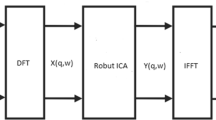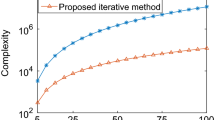Abstract
Although blind source separation of convolutive mixtures can be efficiently solved in the frequency domain, the problem of permutation ambiguity must be solved. Thus, this paper proposes an improved permutation algorithm. Firstly, the improved algorithm uses energy correlation of the separated signal to sort the signals of each frequency bin. Then, the reliability of the sorting of the signals on the frequency bin will be judged according to the threshold. The unreliable frequency bins will be corrected in time so that we can obtain the separated signal accurately, eventually. This algorithm effectively reduces sorting errors and error propagation, thereby improving the separation effect. BSS experiments are performed on the voice signals and radar signals under different convolutive mixing models. The simulation results show that the improved algorithm has better separation performance and higher robustness than the traditional permutation algorithms, which is reflected by the increasing signal to interference ratio of separated signals.









Similar content being viewed by others
References
Xie, Y., Xie, K., & Xie, S. (2020). Underdetermined blind separation of source using l p - norm diversity measures. Neurocomputing, 411, 259–267
Xie, K., Zhou, G., Yang, J., He, Z., & Xie, S. (2019). Eliminating the permutation ambiguity of convolutive blind source separation by using coupled frequency bins. IEEE Transactions on Neural Networks and Learning Systems, 31(2), 589–599
Fu, W., Li, X., Liu, N., & Wei, J. (2017). Parameter blind estimation of frequency-hopping signal based on time-frequency diagram modification. Wireless Personal Communications, 97(3), 3979–3992
Benyamin, M., Genish, H., Califa, R., Wolbromsky, L., Ganani, M., Wang, Z., Zhou, S., Xie, Z., & Zalevsky, Z. (2020). Autoencoder based blind source separation for photoacoustic resolution enhancement. Scientific Reports, 10(1), 21414–21414
Silva, R. F., Plis, S. M., Sui, J., Pattichis, M. S., Adalı, T., & Calhoun, V. D. (2016). Blind source separation for unimodal and multimodal brain networks: A unifying framework for subspace modeling. IEEE Journal of Selected Topics in Signal Processing, 10(7), 1134–1149
Yang, H., Zhang, H., Zhang, J., & Yang, L. (2018). Digital self-interference cancellation based on blind source separation and spectral efficiency analysis for the full-duplex communication systems. IEEE Access, 6, 43946–43955. https://doi.org/10.1109/ACCESS.2018.2864112
Dey, B., Hossain, A., & Dey, R. (2019). Integrated blind signal separation and neural network based energy detector architecture. Wireless Personal Communications, 106(4), 2315–2333
Labounkova, I., Labounek, R., Nestrasil, I., Odstrcilik, J., Tornow, R. P., & Kolar, R. (2020). Blind Source Separation of Retinal Pulsatile Patterns in Optic Nerve Head Video-Recordings. IEEE Transactions on Medical Imaging
Wu X, Hu Y, Li M, Zeng L, Shen H and Hu D. (2017) An improved group BSS-CCA method for blind source separation of functional MRI scans of the human brain. 2017 IEEE 2nd International Conference on Big Data Analysis (ICBDA), Beijing, pp. 758–761 https://doi.org/10.1109/ICBDA.2017.8078739.
Li C, Zhu L and Zhang Z. (2019) Blind Source Separation Via Geometric Segmentation with Canonical Correlation Analysis in Satellite Communications, in 2019 International Symposium on Networks, Computers and Communications (ISNCC), Istanbul, Turkey pp. 1-5
Fu, W., & Zhang, Y. (2019). Wideband blind source separation algorithm based on beamforming. Wireless Personal Communications, 108(1), 221–234
Schulze, S., & King, E. J. (2021). Sparse pursuit and dictionary learning for blind source separation in polyphonic music recordings. EURASIP Journal on Audio, Speech, and Music Processing, 2021(1), 1–25
Debals, O., Van Barel, M., & De Lathauwer, L. (2015). Löwner-based blind signal separation of rational functions with applications. IEEE Transactions on Signal Processing, 64(8), 1909–1918. https://doi.org/10.1109/TSP.2015.2500179
Ourdou, A., Ghazdali, A., Laghrib, A., & Metrane, A. (2021). Blind Separation of Instantaneous Mixtures of Independent/Dependent Sources. Circuits, Systems, and Signal Processing, 1–24
Ma, B., Zhang, T., An, Z., Song, T., & Zhao, H. (2021). A blind source separation method for time-delayed mixtures in underdetermined case and its application in modal identification. Digital Signal Processing, 112, 103007
Xie, K., Zhou, G., Yang, J., He, Z., & Xie, S. (2020). Eliminating the permutation ambiguity of convolutive blind source separation by using coupled frequency bins. IEEE Transactions on Neural Networks and Learning Systems, 31(2), 589–599
Cheng, W., Jia, Z., Chen, X., & Gao, L. (2019). Convolutive blind source separation in frequency domain with kurtosis maximization by modified conjugate gradient. Mechanical Systems and Signal Processing, 134, 106331
Yatabe, K. (2020). Consistent ICA: Determined BSS meets spectrogram consistency. IEEE Signal Processing Letters, 27, 870–874. https://doi.org/10.1109/LSP.2020.2996904
Lv, Z., Zhang, B., Wu, X., Zhang, C., & Zhou, B. (2017). A permutation algorithm based on dynamic time warping in speech frequency-domain blind source separation. Speech Communication: An International Journal, 92, 132–141
Wang, X., Huang, Z., & Zhou, Y. (2014). Underdetermined DOA estimation and blind separation of non-disjoint sources in time-frequency domain based on sparse representation method. Journal of Systems Engineering and Electronics, 25(01), 17–25
Weihong, F., & Cong, Z. (2018). Independent vector analysis convolutive blind separation algorithm based on step-size adaptive. Journal of Electronics & Information Technology, 40(9), 2158–2164
Zhao, W., Li, H., Hao, Y., Zhang, Q., Wu, J., Frederick, B., & Cong, F. (2020). Consistency of independent component analysis for FMRI. Journal of Neuroscience Methods, 351, 109013
Amemuller, J., & Kollmeier, B. (2020). Convolutive blind source separation of speech signals based on amplitude modulation decorrelation. Journal of the Acoustical Society of America, 108(5), 2630–2630
Murata, N., Ikeda, S., & Ziehe, A. (2001). An approach to blind source separation based on temporal structure of speech signals. Neurocomputing, 41(1–4), 1–24
Wang, Z., & Bi, G. (2015, December). A time-frequency preprocessing method for blind source separation of speech signal with temporal structure. In 2015 10th International Conference on Information, Communications and Signal Processing (ICICS), New York. (pp. 1-6). IEEE
Vincent, E., Gribonval, R., & Fevotte, C. (2006). Performance measurement in blind audio source separation. IEEE Transactions on Audio, Speech and Language Processing, 14(4), 1462–1469
Acknowledgements
We gratefully acknowledge the anonymous reviewers who read the drafts and provided many helpful suggestions.
Funding
This work is supported by the National Natural Science Foundation of China (61876143) and the Natural Science Foundation of Shanghai (19ZR1454000).
Author information
Authors and Affiliations
Contributions
All authors contributed to the study conception and design. Material preparation, data collection and analysis were performed by Yichen Zhao, Weihong Fu and Chunhua Zhou. The first draft of the manuscript was written by Yichen Zhao and all authors commented on previous versions of the manuscript. All authors read and approved the final manuscript.
Corresponding author
Ethics declarations
Conflicts of interest
The authors have no relevant financial or non-financial interests to disclose.
Availability of Data and Material
The datasets generated or analyzed and material during this current study are available from the corresponding author on reasonable request.
Code Availability
The codes during this current study are available from the corresponding author on reasonable request.
Additional information
Publisher's Note
Springer Nature remains neutral with regard to jurisdictional claims in published maps and institutional affiliations.
Rights and permissions
About this article
Cite this article
Zhao, Y., Fu, W., Zhou, C. et al. Energy Correlation Permutation Algorithm of Frequency-Domain Blind Source Separation Based on Frequency Bins Correction. Wireless Pers Commun 120, 1753–1768 (2021). https://doi.org/10.1007/s11277-021-08533-w
Accepted:
Published:
Issue Date:
DOI: https://doi.org/10.1007/s11277-021-08533-w




